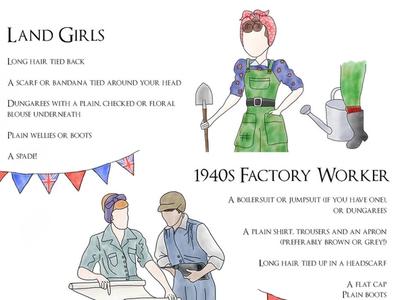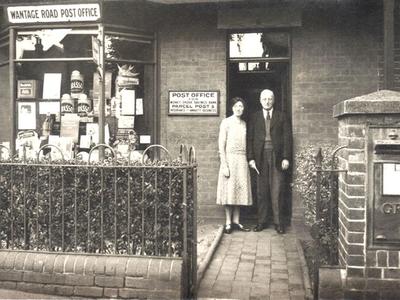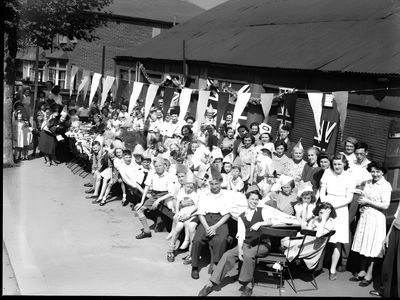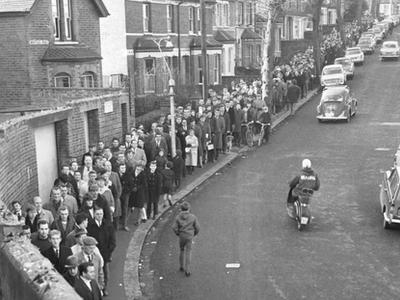Category
History
Unearth the rich past of Wantage Road through archival photos, personal memories and tales that shaped our community.

Street Party Dressing Up
If people are looking to dress up in 1940s style clothes for the Street Party then the Reading Museum website has some great ideas in their VE Day celebration pack: https://www.readingmuseum.org.uk/.../ve-day-celebration-pack. Maybe we'll see plenty of land girls and pilots!

Wantage Road Post Office
The next time you are grumbling about having to walk down Oxford Road to access the nearest Post Office, think about how much easier life would have been when there was one on our street!
Wantage Road Post Office was housed at number 180 and was in operation until its closure in Spring 2008.
One of the early Sub-Postmasters was an Essex man with a French sounding name – William Buteux. Born in 1860, William found love in his early-forties and married Alice Maud Greenaway in Reading in 1903. Sadly, she would pass away in 1910 leaving William as a widower running the Post Office on Wantage Road. He was still there at the age of 60 in 1921 and continued to work up until shortly before his death in 1923, after which he was buried in London Road cemetery.
By 1939 the Sub-Postmaster was Ernest Cox, a local man who had been born in Reading in 1890. Ernest was living at the Post Office with his wife Nellie, whom he had married in 1924. After retiring from his job as Sub-Postmaster, Ernest and Nellie remained in the local area, moving the short distance up to live on Waverley Road. They lived their until they passed away, Ernest in 1971 and Nellie in 1979.
When passing 180 Wantage Road you can still see where the sign used to be above the bay window, and where the post box was on the right hand side where there is now a small fence.
Do you have any memories of the old Post Office or any of the Sub-Postmasters or Sub-Postmistresses that worked there?

🎉 Street party - just one month to go!
We are now just a month away from our street party on July 5th where we will celebrate our community and the joy of peace in Europe. Victory in Europe (VE) Day marks the day that the allies formally accepted the unconditional surrender of Nazi forces, thus bringing the 2nd World War in Europe to an end.
In Reading the Mayor formally announced the end of the war at Queen Victoria’s statue by the Town Hall and street parties were held all over town. You can explore photos of VE Day festivities across Reading on the Reading Museum website – but naturally, the Wantage Road party looks the most fun of all!
🙋♀️ What we need from you
To make this year’s celebration as vibrant and welcoming as the original, we’re looking for:
- Tables and chairs - any folding or outdoor furniture we can borrow for the day to create a long communal table.
- Tablecloths and festive decorations - especially homemade touches that add personality and charm.
- Helpers - to assist with setting up in the morning, decorating, and packing away at the end.
If you can contribute any of these - or want to lend a hand on the day - please get in touch
- Join our Facebook Group to stay updated and connect with other neighbours: Wantage Road Community Group
- Prefer email? Drop us a message here: Contact Form
See you there - and bring your best VE Day spirit!

A stroll through time: Wantage road’s rich history
Long before weekend street parties and modern festivals, Wantage Road was already a bustling hub of community life—its story stretching back well over 30 years. From horse-drawn carts and Victorian terraces to matchday pilgrimages at Elm Park and wartime celebrations, let’s rewind the clock and explore the moments that shaped our street.
Victorian beginnings & early 20th-century life
In the late 1800s, Wantage Road emerged as a residential artery lined with red-brick terraces and modest shopfronts. Horse-drawn delivery carts clattered past for daily essentials, and families set down roots in neat bay-windowed homes. Street lamps were gas-lit, and letterpress notices tacked to telegraph poles announced local news.
Post-war reprieve: Victory in Europe Day, May 1945

Residents draped handmade bunting and crafted newspaper-folded party hats to mark VE Day—joy against the backdrop of war-scarred Britain.
When news of Victory in Europe arrived on May 8, 1945, the street transformed overnight into a scene of jubilation. Improvised bunting—stitched from fabric scraps—and newspaper hats typified the resourcefulness of a community emerging from years of hardship. Long tables groaned under shared fare, and neighbours finally had cause to celebrate together once more.
Elm park matchday rituals, 1950s–1998

Fans queued in brisk morning air, winding around the corner toward Elm Park’s ticket office—eager for every home fixture.
For nearly half a century, Reading Football Club’s Elm Park ground sat just around the corner on Elm Park Road. By the 1950s, throngs of supporters—bowler hats, scarves, and ticket stubs in hand—would snake down Wantage Road, waiting patiently for gates to open. Street vendors seized the opportunity, selling hot tea and match programmes, while neighbours peeked out to gauge the day’s turnout.
- Peak crowds: Attendances regularly topped 20,000, meaning queues could stretch from the turnstiles up to the junction with Waverley Road.
- Community pulse: Matchdays were social events—old friends catching up, local bands sometimes playing impromptu pre-match tunes.

An aerial photograph of Elm Park, the former home of Reading Football Club in the 90's. A great view of the Spread Eagle and Wantage Road at the top.
Architectural shifts & mid-century modern
As car ownership rose in the 1960s and ’70s, front gardens gave way to driveways. Shopfronts modernized their signage, and gas lamps were replaced with electric streetlights. Yet even as the façade changed, the close-knit spirit remained. The Spread Eagle pub (later renamed) and the corner grocer became informal gathering spots where residents traded gossip and good-natured banter.
Why it matters today
These snippets of Wantage Road’s past—VE Day celebrations, Elm Park matchday lines, terrace-house life—remind us that our street has always been more than brick and mortar. It’s a tapestry woven from shared experiences:
Resilience & resourcefulness (wire-stitching bunting from scraps).
Community rituals (weekly football queues forging unlikely friendships).
Ever-evolving streetscape (from horse carts to hatchbacks, gas lamps to LEDs).
As we plan future gatherings—be it commemorations, street fetes, or simply a neighbourly cup of tea—let’s honor these traditions. After all, every generation adds its own chapter to the story of Wantage Road.
Your Turn:
Do you have memories or heirloom photographs dating back before 1995? Share them with us at history@wantage-road.uk so we can keep our community’s heritage alive for decades more.